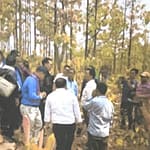The Nilgiris, a hill district in Tamil Nadu, is occupied by various tribal groups. With some tribal hamlets having no proper roads or public transport, providing medical care for the residents is a big challenge for the district administration.
This is where a team of health workers and support staff has proven indispensable. There are currently 94 village health nurses, 128 mid-level health providers and 403 accredited social health activists (ASHA) in the district.
They act as a bridge between the district healthcare system and the tribes, providing basic healthcare to the tribal people at their doorsteps. Navigating rough terrain and shallow water bodies, the health workers often have no option except to walk to the tribal villages.
Kavitha of Kunjapanai is an ASHA worker whose field work from Maamaram takes her to tribal villages inside one of the most dangerous forest in the Niligiris where elephants, gaurs, tigers, leopards, and venomous snakes are found. “There are 10 villages here, but I get time to attend to only 10 people a day as I have to get back by evening to avoid wild elephants on the way,” she says.
Her work includes checking the vitals of the villagers, coordinating with doctors and getting necessary medicines to them, and keeping track of pregnant women and newborn babies. But some are still wary of the visits, she says. “Many tribes cooperate but some people run away on seeing us. Most of them ran into the forest during the COVID-19 vaccination drive and it was extremely difficult to convince them to take the vaccine.”
While the healthcare workers take tremendous efforts to care for the tribal people, some feel their work remains both incomplete and underappreciated.
In spite of all their efforts and treatment, many tribes remain malnourished, Kavitha says.
“Earlier, people used to grow ragi in their own fields. But now they have switched to rice from ration shops,” says P. Sivagami, an ASHA worker. The shift may not be a healthy one, she says.
However, the workers remain steadfast in their drive to deliver care to the isolated hamlets. Poor connectivity, lack of infrastructure, and threat of wild animals are daily challenges that simply need to be overcome.
SATHYAMOORTHY M
Key personnel: The staff act as a bridge between the district health care system and the tribal people, providing basic health care to the tribal people at their doorsteps.
SATHYAMOORTHY M
Long road: A woman brings her grandson for treatment at a primary health care centre.
SATHYAMOORTHY M
The other side: A village health nurse and an ASHA worker cross a waterbody on their way to a tribal village.
SATHYAMOORTHY M
Complete care: The healthcare workers keep track of the vitals of the villagers, coordinate with doctors, and get medicines to the villages.
SATHYAMOORTHY M
Rough terrain: The healthcare workers would often have to walk hours through forests to reach isolated tirbal hamlets.
SATHYAMOORTHY M
No walk in the park: After their rounds, the staff exit via a gate built into a solar-powered electric fence set up around Kolithorai village to keep elephants away.
SATHYAMOORTHY M
Busy days: A village health nurse has breakfast with her husband before leaving for duty.
SATHYAMOORTHY M
Daughters of the soil: An ASHA worker carrying firewood from the forest for domestic use.
SATHYAMOORTHY M
Keeping track: An ASHA worker takes a geo-tagged photo of a new patient in a tribal village.
SATHYAMOORTHY M
Vital check: A mid-level health provider takes the blood pressure of a tribal woman. The service at the doorstep is critical for the vulnerable populatio.
Published – January 05, 2025 11:15 am IST













Remove
SEE ALL